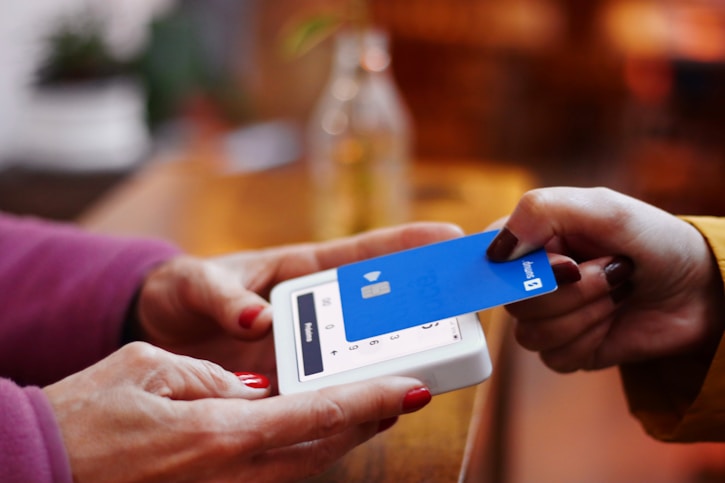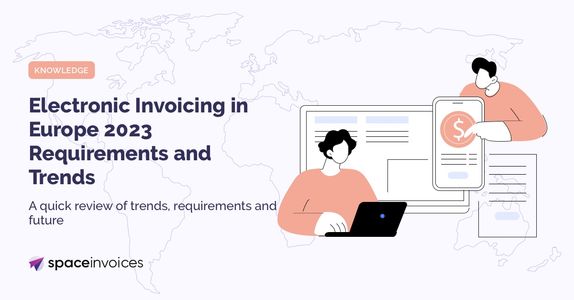Electronic Invoicing in Europe 2023 Requirements and Trends
As both businesses and governments strive to save resources and improve their transactional efficiency with e-invoices, the regulatory landscape surrounding e-invoicing is becoming increasingly stringent.
In the digital age, electronic invoicing (e-invoicing) has emerged as a significant area of focus in the face of ongoing digital transformation, especially within Europe. This surge is driven by a push towards increasingly seamless and efficient business operations, facilitated by the electronic invoice and electronic invoice data interchange systems. As both businesses and governments strive to save resources and improve their transactional efficiency with e-invoices, the regulatory landscape surrounding e-invoicing is becoming increasingly stringent. As we approach the latter part of 2023, several European countries are not just advocating but mandating its use in certain contexts, making e-invoicing the norm. This comprehensive article delves into the current requirements for adopting e-invoicing across Europe, distinguishes e-invoicing from fiscalization and digital invoices, outlines the benefits of efficient e invoice processing and electronic invoice data interchange management, identifies early adopters, highlights trends to look out for in the coming 3-5 years, and suggests the steps companies need to take now to prepare for these forthcoming trends.

What Is Electronic Invoicing (E-Invoicing)?
Electronic invoicing, often abbreviated as e-invoicing, refers to the exchange of invoices in an electronic format between a supplier and a buyer. It is a system that allows businesses to send and receive e-invoices electronically, eliminating the need for paper-based invoices processes and significantly improving the efficiency and accuracy of the invoicing process. Processing of the electronic format of invoices includes issuing, receiving, processing, and archiving of invoice data.
How Do Electronic Invoices Work?
Businesses use e-invoicing to enhance their accounting and enterprise resource planning software. This integration is an automated system designed for businesses who wish to automate the entire invoice process. Let us suppose that companies often charge clients after the shipment of their purchase orders. The system can then send invoices to the customer without requiring any more manual data entry. In a structured digital format the customer receiving an invoice will be able to import it into a business application. Its business model is to provide a service that will satisfy the needs and wants of our clients.
Benefits of E-Invoicing
E-invoicing brings several benefits, including:
Cost savings: It significantly reduces costs related to printing, postage, and storage of paper invoices.
Efficiency: Electronic invoices simplify and speed up the process of invoicing, reduces manual errors, and makes it easier to track and duplicate payments, accounts payable and payments, and manage invoice status.
Environmental sustainability: By eliminating paper invoices, e-invoicing is an environmentally friendly option.
Improved compliance: With real-time data exchange and audit trails, businesses can better comply with tax and legal requirements.
Enhanced supplier-buyer relations: Faster electronic invoice and processing means quicker payments, which can improve supplier-buyer relationships.

Understanding PEPPOL
PEPPOL (Pan-European Public Procurement Online) is an e-procurement and e-invoicing network that simplifies and standardizes digital business document exchange, like e-invoices, within the European Union (EU) and beyond. The network uses open international standards to enable seamless and secure cross-border electronic document exchange between businesses and governments. PEPPOL doesn't replace existing e-invoicing systems but provides a standardized protocol for communication among them. This makes it easier for organizations to send and receive e-invoices across different systems and countries.
PEPPOL consists of different components, including the PEPPOL BIS (Business Interoperability Specifications) for defining the standard formats for business documents, and the PEPPOL eDelivery Network, which is the infrastructure that facilitates the secure exchange of these documents.
The adoption of PEPPOL has grown significantly over recent years. Many European countries, like Norway and Italy, have mandated its use for B2G (business-to-government) invoicing. Moreover, PEPPOL has expanded beyond Europe and has seen adoption in Australia, Singapore, and other nations.
With its ability to simplify cross-border e-invoicing and enhance interoperability, PEPPOL will play an important role in the future of e-invoicing. It may further drive the standardization and adoption of e-invoicing in Europe and worldwide, making it crucial for businesses to understand and potentially adopt this protocol.
E-Invoicing vs. Fiscalization
While both e-invoicing and fiscalization are related to financial transactions, they serve different purposes and have different scopes.
Fiscalization refers to the process of making business transactions visible to the tax authorities in real-time or near real-time. This process generally involves using fiscal devices like cash registers or point-of-sale (POS) systems. The aim is to prevent tax evasion by ensuring that all transactions are correctly recorded and taxes properly paid.
On the other hand, e-invoicing is more about the mode of invoice delivery, aiming to optimize the electronic invoicing process. While e-invoicing also has a role in improving tax compliance, its primary goal is to enhance business efficiency, reduce costs, and contribute to environmental sustainability.
E-Invoicing vs. Digital Invoices
While it may seem that e-invoicing and digital paper invoices are the same, there are differences in scope and functionality. A digital invoice is simply a paper invoice converted into a digital format, such as a PDF. It's essentially an electronic copy of a paper invoice, which can still be manually created, sent, and processed.
E-invoicing, however, is a fully automated, end-to-end invoicing process. It involves integrated e-invoicing software systems between the supplier and the buyer's account payable that can issue, send, receive invoices, and process invoice data without manual intervention. It's not just about digitizing the invoice itself, but about the entire invoice process, including tracking the invoice status.

E-Invoicing Requirements in Europe
Since 2019, with the introduction of the European standard for e-invoicing (EN 16931), the European Union has strongly advocated for businesses to adopt e-invoicing. The objective was to simplify the cross-border public procurement process and to standardize e-invoicing across all Member States.
By 2023, the adoption of e-invoicing has increased dramatically across Europe, and the requirements have become more stringent. Key requirements include:
Standard invoice electronic data interchange format: E-invoices must be in a standa, electronic data interchangeic format (EN 16931) to ensure they are interoperable across all EU member states.
Data protection: Businesses must comply with data protection laws, including the General Data Protection Regulation (GDPR).
Audit trail: The e-invoicing process must provide an audit trail with invoice information for compliance and auditing purposes.
Authenticity and integrity: The e-invoicing accounting system also must ensure the authenticity of origin and integrity of content of the electronic invoicing the system the electronic invoices.
Several European countries have gone beyond these basic requirements, implementing mandatory e-invoicing for certain transactions, particularly for B2G (business-to-government) transactions. Italy, for instance, has made e-invoicing mandatory for all domestic transactions since 2019.
Trends in E-Invoicing in Europe
In 2023, several trends are shaping the e-invoicing landscape in Europe:
Mandatory e-invoicing: More countries are likely to follow Italy's example and make e-invoicing mandatory for certain types of transactions.
Automation: With the development of new technologies and AI, the automation of payment terms the e-invoicing process is becoming more advanced.
Integration of invoices with other business systems: E-invoicing is being integrated with other financial and accounting systems, and processes to further improve business efficiency.
Use of blockchain technology: Some businesses are exploring the use of blockchain technology for e-invoicing to lower costs and increase security and transparency.
E-invoicing is indeed a crucial part of the digital transformation of businesses. As Europe continues to drive the adoption of e-invoicing, companies must keep up with the requirements and trends to reap the benefits and remain competitive in the digital age.

Future Trends in E-Invoicing: 2023-2028
As we look to the future, several key trends are anticipated to shape the e-invoicing landscape over the next half-decade:
Broadening Adoption: As more businesses recognize the multitude of benefits offered by e-invoicing, we anticipate a substantial increase in its adoption. Companies yet to transition to this digital platform will likely do so to maintain competitive parity.
Technological Advancements: Expect the role of machine learning, AI, and data analytics in optimizing and automating the e-invoicing process to increase. As such technologies advance, so too will the efficacy and user-friendliness of e-invoicing systems.
Regulatory Shifts: As e-invoicing and automated systems becomes more mainstream, governments are predicted to refine their own e invoicing system standards and system standards and bolster their regulatory frameworks to safeguard tax compliance and data security. Expect more rigorous standards for e-invoicing processes and systems.
Integration and Interoperability: Over the next few years, we foresee a surge in integration between e-invoicing systems and other financial management platforms, such business systems such as Enterprise Resource Planning (ERP) and accounting software. This will facilitate seamless data exchange and enhance overall operational efficiency.
Blockchain in E-invoicing: Blockchain's application to e-invoicing will likely grow as businesses seek to enhance the security and transparency of invoicing software their e-invoicing systems. Blockchain can validate the authenticity of invoices, streamline the auditing fast payment process, and offer protection against fraudulent activities.
Early Adopters of E-Invoicing in Europe
A handful of European countries have been leading the way in terms of e-invoicing adoption.
Italy notably mandated e-invoicing for all domestic transactions back in 2019, setting a precedent within the European Union.
Spain, too, has made significant strides in promoting e-invoicing, particularly for B2G transactions, while Denmark has mandated the use of e-invoicing for all business to business transactions since 2005. These countries have recognized the need to transition away from manual invoice processing and have embraced the efficiencies and cost savings that e-invoicing offers.
Preparation for Future E-Invoicing Trends
Given the emerging trends and the growing demand for e-invoicing, businesses need to prepare for the future by:
Final Thoughts
In summary, e-invoicing has become an essential part of the business landscape in Europe, driven by both regulatory changes and the recognition of the efficiencies it brings. As we move further into the digital age, it's clear that the adoption of e-invoicing will only continue to grow. Businesses that wish to stay competitive need to embrace this trend, moving away from the manual processes of invoice processing towards efficient, automated, and integrated e-invoicing solutions.
Additional reading:
Start issuing Invoices, free!
Signup and start issuing compliant invoices from your software in minutes.
Or contact us to get a free implementation consultation.
